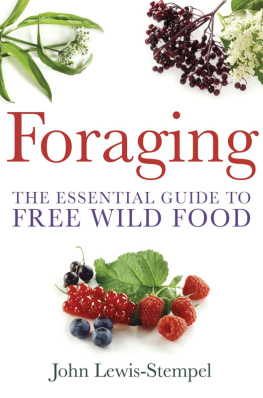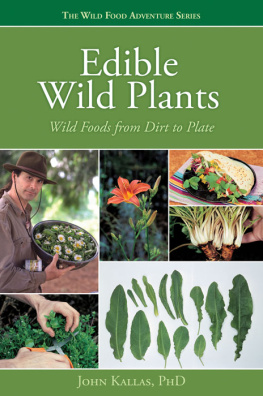For Mary, Ellie and Oscar
Contents
Introduction
I can think of nothing more fulfilling than cooking with food that I have foraged. To feed yourself and those you care about with ingredients sourced by your own hands is to rekindle a relationship with nature, and the simple act of gathering our own food is the way man has existed for the majority of time on this planet. Although this isnt an activity that most people associate with living in a twenty-first-century city, Im sure this book will change the way you look at where you live and allow you to share in some of the wonderful edible experiences that the city has to offer.
It was almost two decades ago that I was properly bitten by the foraging bug, and since then not a day goes by that I dont pick wild food, study wild food and generally obsess about all things related to wild food. I love sharing what Ive learnt, running urban foraging walks, taking groups mushroom hunting in the countryside or combing the seashore. For eight years I ran a busy restaurant and revelled in the task of sourcing wild ingredients from outside the city to add to the menu. Eventually I realized that my greatest foraging pleasures were to be found far closer to home and turned my focus onto the place in which I lived.
Dont be concerned if the idea of eating foraged food in the city feels unsettling at first (take a look at the section where we go through all the dos and donts, common-sense rules, safety, hygiene and legality to put your mind at rest). Im certainly not advocating that you only eat foraged foods even I dont have time for a totally wild diet. I fit the majority of my foraging into short bursts, shoehorned in between working and looking after my young son. Rather, I want you to see how foraged foods can make an incredible addition to the sorts of meals you are already cooking and eating.
More than simply the good eating it affords, putting on your foraging goggles will transform your city surroundings, from somewhere to be hurried through, to a place to be lingered over. Where previously youd notice a patch of stinging nettles to sidestep, I want you to see the opportunity to make delicious wild tempura; rather than avoiding that tree that drops annoyingly sticky petals on your car, I hope youll spot the chance to make a spring blossom champagne. And that clump of weeds it doesnt need clearing, but rather identifying and then incorporating into some wild spring rolls or sushi.
Time spent foraging is as relaxing as it is absorbing; like taking a deep breath, it can bring a feeling of calm to an otherwise frenetic city. Simply walking from my house to the nearest station has become a voyage of discovery, a multi-sensory experience and a treasure hunt, during which I find myself smiling rather a lot.
The standard definition of foraging is this: the act of looking or searching for food or provisions. The basics are simple and easy to learn, with a good sense of smell being more important than the ability to memorize hundreds of Latin names and complicated plant diagrams. My approach is to take the tiniest bit of knowledge and put it to multiple uses; so simply being able to identify a dandelion will provide countless, year-round foraging opportunities and produce culinary delights as diverse as a caffeine-free coffee, a mid-summer wine, roasted winter root vegetables and spring salads, all from just one, very easy to identify, common as you like, weed.
You can use this book however you prefer; read it from front to back, all in one go, or dip in sporadically when you have a free moment, heading for the current month, or just pick an ingredient or recipe at random and modify it to suit whats in season or whatever you currently have access to. Necessity is often called the mother of invention, but availability, for foragers at least, is where the real inspiration lies. The type of cooking that comes from using foraged ingredients is naturally creative, inventive and ad hoc. These wont be the kind of recipes where things are always measured precisely; a handful is often about as accurate as I get.
There are no real rules, other than avoiding the plants that arent edible or for whatever reason are not safe to eat, but with enthusiasm and some common sense, a magical side of the city and its hidden larder is waiting to be discovered, probably right on your doorstep. I hope this book takes you on your own food journey, even if it just means you pay a bit more attention to the plants in your local park. With a little effort, it will allow you to begin viewing the city as I do, as a constant source of wonder, an ongoing education and a provider of almost daily inspiration. If foraging teaches us anything, its to enjoy and celebrate what is available, not to hanker after what is not.
Where to forage
I live in London and much of the foraging I describe occurs there, but the majority of the plants I pick are in no way specific to the south-east or even the UK. Almost all of them are freely available across northern Europe, actually right across the northern temperate zone, which spans the globe, taking in countries as diverse as North America and Japan. Every country has its own common or local names for these plants, in fact most of them have many variations, so Ive supplied the Latin names, which are always useful to refer back to in case of any confusion (). Once you start to look, youll see the real problem is not finding food to forage for but choosing between so many options. On a spring walk through the unremarkable city park nearest to my house I can easily find lemon balm, spearmint, primrose, white nettle, poppy and yarrow growing at my feet, while above me are avenues of mulberry, hazel, elder, linden, cherry plum and hawthorn trees. Is my local park a particularly outstanding place? Well, yes and no. It has all the things I look for: a mix of well-kept and clean areas, combined with some intentionally wild patches and a few less-intentional ones, interesting tree planting and a decent-sized lake, pond or waterway (the border of which is not overly managed). Basically it ticks all the foraging boxes but is no different from another hundred city parks I can think of, so for me, my local park is outstanding, not just for my purposes but for the many other ways in which it provides for the local and wider community.
From this one square mile of almost central London, I have identified, collected and eaten nearly 200 different edible plants, many of them giving me multiple crops spread out across the year.
In this book, I take you in detail through sixty of the most common and tastiest, but I reference many, many more.
The plants themselves fall into two, totally non-botanical groups. First, the genuine wild plants, unconcerned with the patchwork of grey blobs that make up the view of London on Google Earth; they are opportunistically able to grow anywhere, colonize a patch of turned-over soil at a moments notice or barge their way up through cracks in the pavement. Wild plants dont need looking after, dont need feeding, pruning, watering or tending to in any way; robust, hardy, militant, were we to cease to be, I have no doubt that they would reclaim the city at a startling speed. The second group are the unintentionally edible or medicinal plants, favoured for planting by both current and Victorian park and town planners, often forming entire avenues of trees or huge lines of bushes. The end result of all this intentional planting coupled with the prolific growth of wild plants and feral/garden escapees, all thriving in the microclimate that is Greater London is a huge area of natural diversity, as fertile and bountiful as anywhere else in the country.





